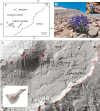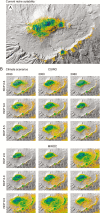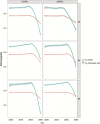Alpine species in dynamic insular ecosystems through time: conservation genetics and niche shift estimates of the endemic and vulnerable Viola cheiranthifolia
- PMID: 30307538
- PMCID: PMC6377099
- DOI: 10.1093/aob/mcy185
Alpine species in dynamic insular ecosystems through time: conservation genetics and niche shift estimates of the endemic and vulnerable Viola cheiranthifolia
Abstract
Background and aims: Alpine oceanic ecosystems are considered amongst the most ephemeral and restricted habitats, with a biota highly vulnerable to climate changes and disturbances. As an example of an alpine insular endemic, the past and future population genetic structure and diversity, and the future distribution of Viola cheiranthifolia (Violaceae), endemic to Tenerife (Canary Islands), were estimated. The main goals were to predict distribution changes of this alpine oceanic plant under climate change, and to assist in actions for its conservation.
Methods: To perform population genetic analysis, 14 specific microsatellite markers and algorithms which considered the polyploid condition of V. cheiranthifolia were employed. The niche modelling approach incorporated temperature gradients, topography and snow cover maps. Models were projected into climate change scenarios to assess the extent of the altitudinal shifts of environmental suitability. Finally, simulations were performed to predict whether the environmental suitability loss will affect the genetic diversity of populations.
Key results: Viola cheiranthifolia presents short dispersal capacity, moderate levels of genetic diversity and a clear population genetic structure divided into two main groups (Teide and Las Cañadas Wall), showing signs of recolonization dynamics after volcanic eruptions. Future estimates of the distribution of the study populations also showed that, despite being extremely vulnerable to climate change, the species will not lose all its potential area in the next decades. The simulations to estimate genetic diversity loss show that it is correlated to suitability loss, especially in Las Cañadas Wall.
Conclusions: The low dispersal capacity of V. cheiranthifolia, coupled with herbivory pressure, mainly from rabbits, will make its adaptation to future climate conditions in this fragile alpine ecosystem difficult. Conservation actions should be focused on herbivore control, population reinforcement and surveillance of niche shifts, especially in Guajara, which represents the oldest isolated population and a genetic reservoir for the species.
Keywords: Viola cheiranthifolia; Alpine; Canary Islands; climate change; conservation genetics; genetic diversity loss; microsatellites; niche modelling; oceanic; polyploid; short-distance dispersal; volcanism.
© The Author(s) 2018. Published by Oxford University Press on behalf of the Annals of Botany Company. All rights reserved. For permissions, please e-mail: journals.permissions@oup.com.
Figures






Similar articles
-
Forecast increase in invasive rabbit spread into ecosystems of an oceanic island (Tenerife) under climate change.Ecol Appl. 2021 Jan;31(1):e02206. doi: 10.1002/eap.2206. Epub 2020 Sep 9. Ecol Appl. 2021. PMID: 32627262
-
Fitness and genetic variation of Viola calaminaria, an endemic metallophyte: implications of population structure and history.Plant Biol (Stuttg). 2008 Nov;10(6):684-93. doi: 10.1111/j.1438-8677.2008.00077.x. Plant Biol (Stuttg). 2008. PMID: 18950425
-
Past and future demographic dynamics of alpine species: limited genetic consequences despite dramatic range contraction in a plant from the Spanish Sierra Nevada.Mol Ecol. 2013 Aug;22(16):4177-4195. doi: 10.1111/mec.12383. Epub 2013 Jul 12. Mol Ecol. 2013. PMID: 23844700
-
Facilitating climate-change-induced range shifts across continental land-use barriers.Conserv Biol. 2015 Dec;29(6):1586-95. doi: 10.1111/cobi.12556. Epub 2015 Jul 20. Conserv Biol. 2015. PMID: 26193759 Review.
-
Implications of climate change for the fishes of the British Isles.J Fish Biol. 2009 Apr;74(6):1143-205. doi: 10.1111/j.1095-8649.2009.02180.x. J Fish Biol. 2009. PMID: 20735625 Review.
Cited by
-
Evolution and conservation genetics of an insular hemiparasitic plant lineage at the limit of survival: the case of Thesium sect. Kunkeliella in the Canary Islands.Am J Bot. 2022 Mar;109(3):419-436. doi: 10.1002/ajb2.1830. Epub 2022 Mar 15. Am J Bot. 2022. PMID: 35289923 Free PMC article.
-
Effects of insularity on genetic diversity within and among natural populations.Ecol Evol. 2022 May 7;12(5):e8887. doi: 10.1002/ece3.8887. eCollection 2022 May. Ecol Evol. 2022. PMID: 35571757 Free PMC article.
-
The gathering storm: optimizing management of coastal ecosystems in the face of a climate-driven threat.Ann Bot. 2020 Feb 3;125(2):197-212. doi: 10.1093/aob/mcz204. Ann Bot. 2020. PMID: 31837218 Free PMC article. Review.
-
Cyclotide host-defense tailored for species and environments in violets from the Canary Islands.Sci Rep. 2021 Jun 14;11(1):12452. doi: 10.1038/s41598-021-91555-y. Sci Rep. 2021. PMID: 34127703 Free PMC article.
References
-
- Ancochea E, Huertas MJ, Cantagrel JM, et al. . 1999. Evolution of the Cañadas edifice and its implications for the origin of the Cañadas Caldera (Tenerife, Canary Island). Journal of Volcanology and Geothermal Research 88: 177–199.
-
- Ballard HE, Sytsma KJ, Kowal RR. 1999. Shrinking the violets: phylogenetic relationships of infrageneric groups in Viola (Violaceae) based on internal transcribed spacer DNA sequences. Systematic Botany 23: 439–458.
-
- del Barrio GD, Puigdefabregas J, Sanjuán ME, Ruiz A. 2013. R package; r2dRue.
-
- Beattie AJ, Lyons N. 1975. Seed dispersal in Viola (Violaceae): adaptations and strategies. American Journal of Botany 62: 714–722.
Publication types
MeSH terms
LinkOut - more resources
Full Text Sources
Medical
Research Materials
Miscellaneous

